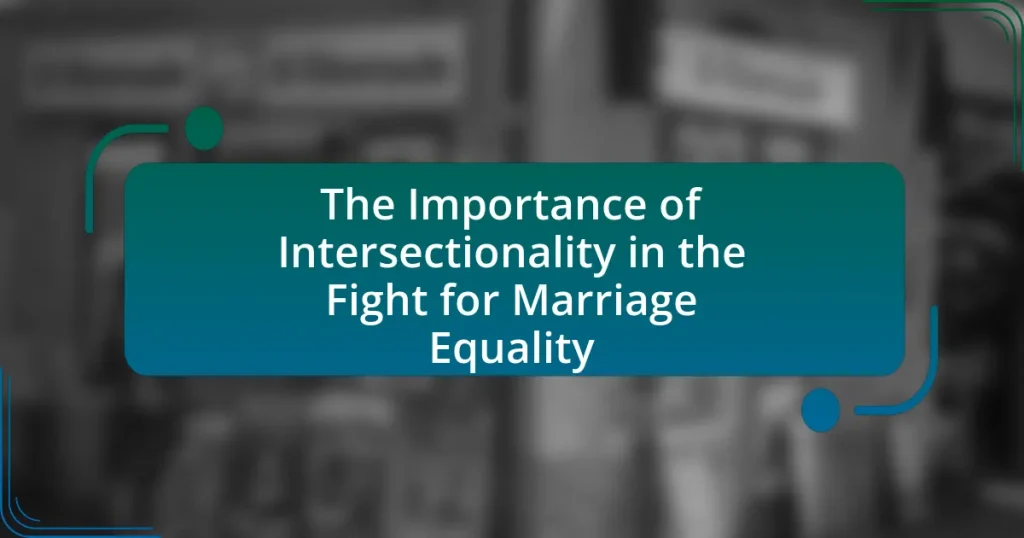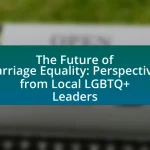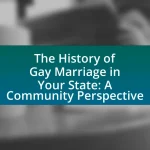Intersectionality is a critical framework that examines how various social identities, including race, gender, sexual orientation, and class, intersect to shape unique experiences of discrimination and privilege. This article explores the significance of intersectionality in the fight for marriage equality, emphasizing that marginalized groups, particularly LGBTQ+ individuals of color, face compounded barriers that differ from those experienced by their white counterparts. It discusses the historical context of civil rights movements, the current challenges faced by diverse communities, and the necessity of inclusive advocacy strategies that address the specific needs of all individuals seeking marriage rights. By integrating intersectional perspectives, the article highlights how effective policy-making and advocacy can promote equity and justice in the pursuit of marriage equality.
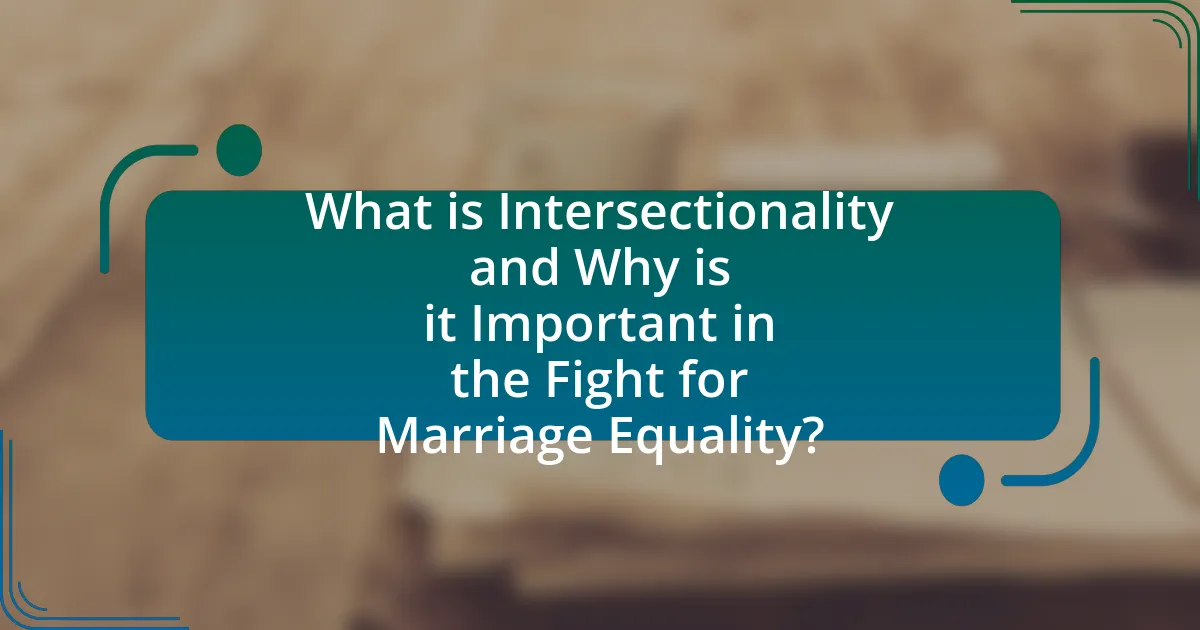
What is Intersectionality and Why is it Important in the Fight for Marriage Equality?
Intersectionality is a framework that examines how various social identities, such as race, gender, sexual orientation, and class, intersect to create unique experiences of discrimination and privilege. This concept is crucial in the fight for marriage equality because it highlights that not all individuals experience the same barriers; for example, LGBTQ+ people of color face compounded discrimination compared to their white counterparts. Research by Kimberlé Crenshaw, who coined the term, emphasizes that understanding these intersections allows advocates to address the specific needs of marginalized groups effectively, ensuring that marriage equality efforts are inclusive and equitable.
How does intersectionality influence the understanding of marriage equality?
Intersectionality influences the understanding of marriage equality by highlighting how various social identities, such as race, gender, sexual orientation, and class, intersect to create unique experiences of discrimination and privilege. This framework reveals that the fight for marriage equality is not uniform; for instance, LGBTQ+ individuals from marginalized racial backgrounds may face compounded barriers that differ from those experienced by white LGBTQ+ individuals. Research by Crenshaw (1989) introduced the concept of intersectionality, emphasizing that policies and advocacy efforts must consider these overlapping identities to effectively address the diverse needs of all individuals seeking marriage equality. Thus, intersectionality provides a more nuanced understanding of the challenges faced in achieving marriage equality, ensuring that the movement is inclusive and representative of all voices.
What are the key components of intersectionality in this context?
The key components of intersectionality in the context of marriage equality include the interconnectedness of various social identities such as race, gender, sexual orientation, and socioeconomic status. These components highlight how individuals experience discrimination and privilege differently based on their unique combinations of identities. For instance, research by Crenshaw (1989) emphasizes that marginalized groups, particularly women of color, face distinct challenges that cannot be understood by examining race or gender in isolation. This framework is crucial in advocating for marriage equality, as it ensures that the diverse experiences of all individuals, especially those at the intersections of multiple identities, are recognized and addressed in policy and activism.
How does intersectionality affect different marginalized groups in the fight for marriage equality?
Intersectionality significantly impacts different marginalized groups in the fight for marriage equality by highlighting how overlapping identities, such as race, gender, sexual orientation, and socioeconomic status, create unique challenges and experiences. For instance, Black LGBTQ+ individuals often face both racial discrimination and homophobia, which can complicate their access to marriage rights compared to their white counterparts. Research from the Williams Institute indicates that LGBTQ+ people of color experience higher rates of discrimination and violence, which underscores the necessity of addressing these intersecting identities in advocacy efforts. This intersectional approach ensures that the fight for marriage equality is inclusive and responsive to the diverse needs of all marginalized groups, rather than a one-size-fits-all solution.
Why is it essential to consider intersectionality in advocacy for marriage equality?
Considering intersectionality in advocacy for marriage equality is essential because it acknowledges the diverse experiences and challenges faced by individuals based on their intersecting identities, such as race, gender, sexual orientation, and socioeconomic status. This approach ensures that advocacy efforts are inclusive and address the unique barriers that marginalized groups encounter in accessing marriage rights. For instance, research by the Movement Advancement Project highlights that LGBTQ+ people of color face higher rates of discrimination and economic instability, which can hinder their ability to advocate for marriage equality effectively. By integrating intersectionality, advocates can create more comprehensive strategies that promote equity and justice for all individuals, rather than a one-size-fits-all solution that may overlook specific needs and experiences.
What are the potential consequences of ignoring intersectionality in this fight?
Ignoring intersectionality in the fight for marriage equality can lead to the marginalization of specific groups, resulting in policies that do not address the unique challenges faced by individuals at the intersections of multiple identities, such as race, gender, and socioeconomic status. This oversight can perpetuate systemic inequalities, as evidenced by studies showing that LGBTQ+ individuals of color experience higher rates of discrimination and violence compared to their white counterparts. Furthermore, failing to consider intersectionality can alienate potential allies and weaken coalitions, ultimately hindering progress toward comprehensive equality. For instance, the Human Rights Campaign has highlighted that inclusive advocacy is essential for addressing the diverse needs of all community members, emphasizing that a one-size-fits-all approach is insufficient.
How can intersectionality enhance the effectiveness of marriage equality campaigns?
Intersectionality can enhance the effectiveness of marriage equality campaigns by addressing the diverse experiences and challenges faced by individuals at the intersection of multiple identities, such as race, gender, and socioeconomic status. By recognizing that not all individuals experience discrimination or privilege in the same way, campaigns can tailor their messages and strategies to resonate with a broader audience, ensuring inclusivity. For instance, research from the American Psychological Association indicates that marginalized groups, including LGBTQ+ people of color, often face compounded discrimination, which can hinder their access to marriage equality. By incorporating intersectional perspectives, campaigns can advocate for policies that address these unique barriers, ultimately fostering a more equitable movement that reflects the realities of all individuals involved.
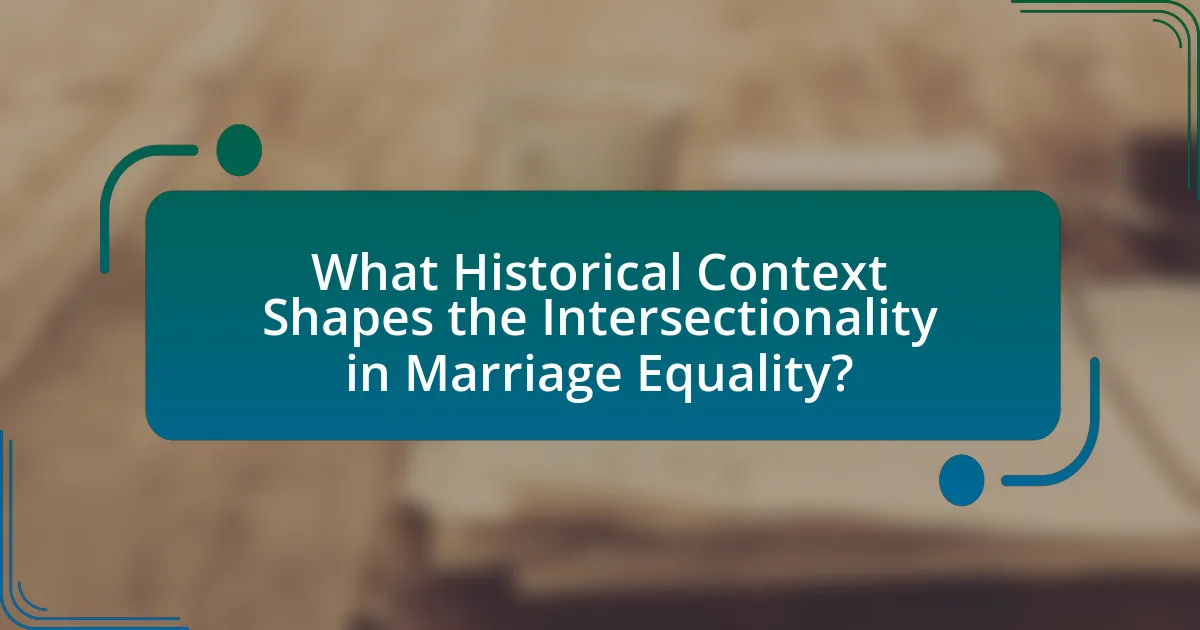
What Historical Context Shapes the Intersectionality in Marriage Equality?
The historical context that shapes the intersectionality in marriage equality includes the civil rights movements, LGBTQ+ activism, and the socio-political landscape surrounding race, gender, and sexuality. The civil rights movement of the 1960s laid the groundwork for advocating equality, influencing LGBTQ+ rights by highlighting systemic discrimination. Landmark events, such as the Stonewall Riots in 1969, marked a pivotal moment in LGBTQ+ activism, emphasizing the need for intersectional approaches that consider race, class, and gender identity alongside sexual orientation. Additionally, the Defense of Marriage Act (DOMA) of 1996 and its subsequent repeal in 2013 by the Supreme Court in United States v. Windsor further illustrated the evolving legal landscape and the necessity of recognizing diverse identities within the marriage equality framework. These historical milestones demonstrate how intersectionality is crucial in understanding and addressing the complexities of marriage equality.
How have historical movements influenced the current understanding of marriage equality?
Historical movements have significantly shaped the current understanding of marriage equality by advocating for the rights of marginalized groups and challenging societal norms. The civil rights movement of the 1960s laid the groundwork for later LGBTQ+ activism, emphasizing equality and justice, which directly influenced the push for marriage rights. Landmark events, such as the Stonewall Riots in 1969, galvanized the LGBTQ+ community and highlighted the need for legal recognition of same-sex relationships. Additionally, the fight against HIV/AIDS in the 1980s brought attention to the discrimination faced by gay individuals, further solidifying the demand for marriage equality as a matter of civil rights. These historical movements collectively contributed to a broader societal understanding that marriage equality is essential for achieving true equality and justice for all individuals, regardless of sexual orientation.
What role did civil rights movements play in shaping marriage equality discussions?
Civil rights movements significantly influenced marriage equality discussions by framing the struggle for LGBTQ+ rights within the broader context of human rights and equality. Activists drew parallels between the fight against racial discrimination and the fight for same-sex marriage, emphasizing that both issues stem from a fundamental denial of equal rights. For instance, the landmark Supreme Court case Obergefell v. Hodges in 2015, which legalized same-sex marriage nationwide, was bolstered by arguments that highlighted the historical injustices faced by marginalized groups, including people of color and LGBTQ+ individuals. This intersectional approach helped to galvanize support across diverse communities, illustrating that the fight for marriage equality was not just a singular issue but part of a larger quest for social justice and equality for all.
How have LGBTQ+ rights intersected with other social justice movements historically?
LGBTQ+ rights have historically intersected with other social justice movements, particularly those advocating for racial equality, women’s rights, and disability rights. For instance, the Stonewall Riots of 1969, a pivotal moment in LGBTQ+ activism, were influenced by the civil rights movement and included activists from diverse racial backgrounds, highlighting the interconnectedness of these struggles. Additionally, the fight for marriage equality has often aligned with feminist movements, as both advocate for the recognition of personal autonomy and equal rights under the law. The collaboration between LGBTQ+ activists and other social justice groups has been evident in events like Pride marches, which have included calls for racial justice and economic equality, demonstrating that the fight for LGBTQ+ rights is part of a broader struggle for human rights.
What lessons can be learned from past struggles for equality?
Past struggles for equality teach the importance of intersectionality in advocacy efforts. Intersectionality highlights how various social identities, such as race, gender, and sexual orientation, intersect to create unique experiences of discrimination. For instance, the Civil Rights Movement of the 1960s demonstrated that the fight for racial equality could not be separated from issues of gender and class, as seen in the activism of figures like Rosa Parks and Angela Davis. Additionally, the LGBTQ+ rights movement has shown that marginalized groups within the community, such as people of color and transgender individuals, face compounded challenges that require tailored approaches. The 2015 Supreme Court ruling in Obergefell v. Hodges, which legalized same-sex marriage, underscored the necessity of inclusive strategies that address the diverse needs of all individuals seeking equality. These historical examples illustrate that successful movements must embrace intersectionality to effectively combat systemic inequalities.
How can these lessons inform current advocacy efforts?
Lessons on intersectionality can inform current advocacy efforts by emphasizing the need to address the diverse experiences and challenges faced by marginalized groups within the marriage equality movement. Recognizing that factors such as race, gender identity, and socioeconomic status intersect to shape individuals’ experiences allows advocates to create more inclusive policies and strategies. For instance, studies have shown that LGBTQ+ individuals of color face higher rates of discrimination and violence, highlighting the necessity for tailored advocacy that addresses these specific issues. By integrating intersectional perspectives, advocacy efforts can mobilize broader coalitions and foster solidarity among various marginalized communities, ultimately leading to more effective and equitable outcomes in the fight for marriage equality.
What historical examples highlight the importance of intersectionality in social movements?
Historical examples that highlight the importance of intersectionality in social movements include the Civil Rights Movement and the LGBTQ+ rights movement. During the Civil Rights Movement, figures like Angela Davis emphasized how race, gender, and class intersected, advocating for the rights of Black women who faced unique challenges compared to their male counterparts. In the LGBTQ+ rights movement, the Stonewall Riots of 1969 showcased the intersection of race, gender identity, and sexual orientation, as trans women of color, such as Marsha P. Johnson and Sylvia Rivera, played crucial roles in the uprising, highlighting the need for inclusivity within the movement. These examples demonstrate that addressing multiple identities is essential for achieving comprehensive social justice.

How Does Intersectionality Manifest in Current Marriage Equality Debates?
Intersectionality manifests in current marriage equality debates by highlighting how various social identities, such as race, gender, and socioeconomic status, intersect to shape individuals’ experiences and access to rights. For instance, LGBTQ+ individuals of color often face compounded discrimination that affects their ability to advocate for marriage equality, as seen in studies showing that Black and Latino LGBTQ+ individuals report higher rates of discrimination compared to their white counterparts. This intersectional lens reveals that the fight for marriage equality is not solely about legal recognition but also involves addressing broader systemic inequalities that impact marginalized communities.
What are the current challenges faced by marginalized groups in the fight for marriage equality?
Marginalized groups face significant challenges in the fight for marriage equality, including systemic discrimination, lack of legal protections, and social stigma. Systemic discrimination manifests in various forms, such as unequal access to legal resources and representation, which disproportionately affects LGBTQ+ individuals of color and those from low-income backgrounds. Additionally, many states lack comprehensive anti-discrimination laws, leaving marginalized groups vulnerable to legal inequalities. Social stigma, fueled by cultural and religious opposition, further complicates their struggle, often resulting in isolation and mental health issues. According to a 2020 report by the Williams Institute, LGBTQ+ people of color experience higher rates of discrimination and violence, highlighting the urgent need for intersectional approaches to address these challenges effectively.
How do race, gender, and socioeconomic status intersect in marriage equality issues?
Race, gender, and socioeconomic status intersect in marriage equality issues by creating unique barriers and experiences for individuals seeking legal recognition of their relationships. For instance, marginalized racial groups often face systemic discrimination that complicates their access to marriage rights, as evidenced by studies showing that Black and Latino LGBTQ+ individuals experience higher rates of poverty and discrimination compared to their white counterparts. Gender dynamics also play a crucial role; women, particularly women of color, may encounter additional societal pressures and economic disparities that affect their ability to marry or maintain stable relationships. Furthermore, socioeconomic status significantly influences access to legal resources and support systems, with lower-income individuals facing challenges in navigating the legal complexities of marriage equality. Research from the Williams Institute highlights that LGBTQ+ individuals from lower socioeconomic backgrounds are less likely to have access to legal representation, which can hinder their ability to secure marriage rights. Thus, the intersection of race, gender, and socioeconomic status creates a multifaceted landscape that impacts the fight for marriage equality.
What specific barriers do different communities face in accessing marriage rights?
Different communities face various barriers in accessing marriage rights, including legal, cultural, economic, and social obstacles. For instance, LGBTQ+ individuals often encounter discriminatory laws that prevent them from marrying in certain jurisdictions, as evidenced by the Defense of Marriage Act in the United States prior to its repeal in 2013. Additionally, racial and ethnic minorities may face cultural stigmas or familial opposition that complicate their ability to marry. Economic barriers also play a significant role; low-income individuals may struggle with the costs associated with marriage licenses and ceremonies. Furthermore, individuals with disabilities may encounter accessibility issues that hinder their ability to participate in the marriage process. These barriers highlight the intersectionality of various identities and the need for comprehensive reforms to ensure equitable access to marriage rights for all communities.
How can intersectional approaches improve policy-making for marriage equality?
Intersectional approaches can improve policy-making for marriage equality by ensuring that the diverse experiences and needs of various marginalized groups are considered. This inclusivity leads to more comprehensive and effective policies that address the unique barriers faced by individuals at the intersection of multiple identities, such as race, gender, sexual orientation, and socioeconomic status. For instance, research from the Williams Institute indicates that LGBTQ+ people of color experience higher rates of discrimination and economic disadvantage compared to their white counterparts, highlighting the necessity for policies that specifically target these disparities. By integrating intersectionality into policy-making, lawmakers can create solutions that not only promote marriage equality but also enhance overall social justice and equity for all individuals.
What strategies can advocates use to incorporate intersectionality into their work?
Advocates can incorporate intersectionality into their work by actively engaging with diverse communities and understanding the unique challenges faced by individuals at the intersections of multiple identities. This approach involves conducting thorough research to identify how factors such as race, gender, sexual orientation, and socioeconomic status influence experiences of discrimination and privilege. For instance, studies have shown that LGBTQ+ individuals of color often face compounded discrimination, which necessitates tailored advocacy strategies that address these specific issues. Additionally, advocates can collaborate with grassroots organizations that represent marginalized groups, ensuring that their voices are included in policy discussions and decision-making processes. This collaborative approach not only amplifies underrepresented perspectives but also fosters a more inclusive movement for marriage equality.
How can policymakers ensure that marriage equality laws are inclusive?
Policymakers can ensure that marriage equality laws are inclusive by actively engaging with diverse communities to understand their unique needs and challenges. This engagement can be achieved through public consultations, surveys, and collaboration with advocacy groups representing various identities, including racial, ethnic, and socioeconomic backgrounds. For instance, research from the Williams Institute indicates that LGBTQ+ individuals of color face distinct barriers to marriage equality, highlighting the necessity for tailored approaches in legislation. By incorporating intersectional perspectives, policymakers can create laws that not only recognize same-sex marriage but also address the specific inequalities faced by marginalized groups within the LGBTQ+ community.
What Practical Steps Can Be Taken to Promote Intersectionality in the Fight for Marriage Equality?
To promote intersectionality in the fight for marriage equality, advocacy groups should actively include diverse voices and experiences in their campaigns. This can be achieved by forming coalitions with organizations representing marginalized communities, such as people of color, individuals with disabilities, and LGBTQ+ individuals from various backgrounds. Research indicates that inclusive advocacy leads to more comprehensive policy outcomes; for instance, the 2015 Supreme Court ruling in Obergefell v. Hodges, which legalized same-sex marriage, was influenced by diverse advocacy efforts that highlighted the unique challenges faced by different groups within the LGBTQ+ community. Additionally, educational programs that raise awareness about intersectionality can empower activists to address the specific needs of various demographics, ensuring that the fight for marriage equality is equitable and inclusive.
What resources are available for advocates to learn about intersectionality?
Advocates can access a variety of resources to learn about intersectionality, including academic texts, online courses, and community workshops. Notable academic texts include “Intersectionality” by Kimberlé Crenshaw, which lays the foundational theory of intersectionality, and “Sister Outsider” by Audre Lorde, which explores the complexities of identity. Online platforms like Coursera and edX offer courses on intersectionality, often developed by universities and experts in the field. Additionally, organizations such as the American Psychological Association provide webinars and articles that discuss intersectionality in various contexts, including social justice and marriage equality. These resources collectively enhance understanding and application of intersectionality in advocacy work.
How can individuals contribute to a more intersectional approach in their communities?
Individuals can contribute to a more intersectional approach in their communities by actively engaging in inclusive dialogues that recognize and address the diverse experiences of marginalized groups. This engagement can involve participating in community forums, advocating for policies that consider multiple identities, and supporting organizations that prioritize intersectionality in their work. Research indicates that intersectional advocacy leads to more comprehensive solutions, as seen in the work of the Movement for Black Lives, which emphasizes the interconnectedness of racial, gender, and economic justice. By fostering understanding and collaboration among different groups, individuals can help create a more equitable environment that supports marriage equality and other social justice initiatives.
